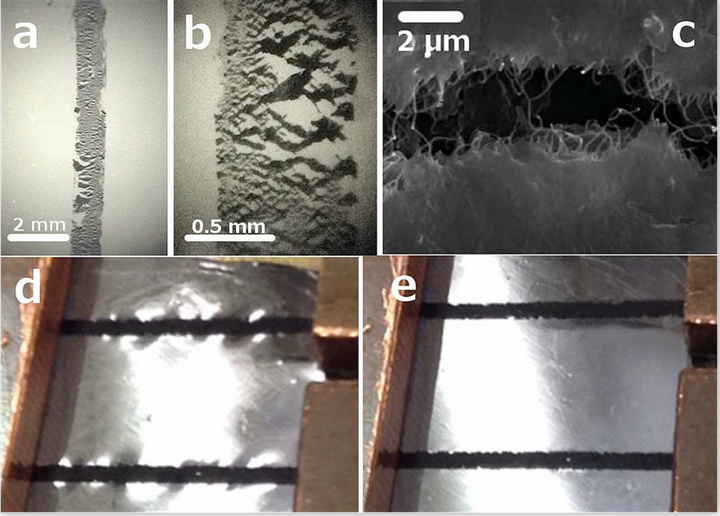“Self-grafting carbon nanotubes on polymeric supports for stretchable electronics tailored to medical application”
 A fundamental requirement for the application of devices to the medical technology sectors is the biocompatibility associated with mechanical characteristics of elasticity and plasticity. Over the last three years, the UTV team has created and characterized polymeric materials, submillimetric flexible-plastic-extensible electrical conductors, for the extraction of cerebral corticogram signals aimed at guiding prostheses and diagnosing and treating epilepsy. The ultimate aim is to replace traditional metal electrodes for detecting the electrical signal from the brain, with detection points distributed with micrometric precision on a polymeric membrane that acts as a meninge. The techniques used for the characterization were optical microscopies, SEM, AFM, and conductance measurements as a function of deformation. Following the creation of the node, the UTV group intends to further expand the research and development of these new polymeric materials, flexible-plastic-extensible electrical conductors, particularly innovative in the most varied industrial sectors, such as electronics and information technology, rehabilitation and prosthetic medicine (prosthesis capable of acquiring signals directly in the brain, mechanical sensors), automotive and aeronautics, environmental sensors (anemometry, flowmeters, etc.), photovoltaics on sails and curtains, fashion (materials for clothes with designs and programmable and editable colors). In these areas, by way of example, the team is currently determining the equivalent impedance according to its geometric shape, the deformation and the relative position of the electrical contacts, the development of systems for analyzing cortical signals for the identification of contributions independent of parameters electrode geometries, and the development of prototypes of antennas based on carbon polymer-nanotube composites for wireless communications. Tasks accomplished include:
A fundamental requirement for the application of devices to the medical technology sectors is the biocompatibility associated with mechanical characteristics of elasticity and plasticity. Over the last three years, the UTV team has created and characterized polymeric materials, submillimetric flexible-plastic-extensible electrical conductors, for the extraction of cerebral corticogram signals aimed at guiding prostheses and diagnosing and treating epilepsy. The ultimate aim is to replace traditional metal electrodes for detecting the electrical signal from the brain, with detection points distributed with micrometric precision on a polymeric membrane that acts as a meninge. The techniques used for the characterization were optical microscopies, SEM, AFM, and conductance measurements as a function of deformation. Following the creation of the node, the UTV group intends to further expand the research and development of these new polymeric materials, flexible-plastic-extensible electrical conductors, particularly innovative in the most varied industrial sectors, such as electronics and information technology, rehabilitation and prosthetic medicine (prosthesis capable of acquiring signals directly in the brain, mechanical sensors), automotive and aeronautics, environmental sensors (anemometry, flowmeters, etc.), photovoltaics on sails and curtains, fashion (materials for clothes with designs and programmable and editable colors). In these areas, by way of example, the team is currently determining the equivalent impedance according to its geometric shape, the deformation and the relative position of the electrical contacts, the development of systems for analyzing cortical signals for the identification of contributions independent of parameters electrode geometries, and the development of prototypes of antennas based on carbon polymer-nanotube composites for wireless communications. Tasks accomplished include:- Design and construction of microfabrication of elastic electrodes matrices based on polyethylene-carbon nanotubes composite which are engineered at points of detection of the electrical signal from the brain, distributed with micrometric precision on a polymeric membrane that acts as a meninge. A first series of devices has been successfully tested in vivo by obtaining a six-channel electrocorticogram for 11 weeks on a rat that is free to move and healthy. The test results are reported in the article “Self-grafting carbon nanotubes on polymers for stretchable electronics”, P. Morales et al., Eur. Phys. J. Plus (2018) 133, 214 [3] and a technical description and videos available at the link in ref [4]. Carbon nanotubes, naturally organized in tangles following growth, endow the composite with its electrical conduction properties, while polyethylene, an excellent electrical insulator and with particularly suitable mechanical properties, constitutes the film that acts as a blood barrier. brain. Both materials are elastic and plastic, and are completely inert and inherently biocompatible. The research, all Italian, therefore has the aim of creating innovative devices to be implanted in the brain to record nerve signals; “Sensors that make a significant contribution to the diagnosis, control and monitoring of neurological diseases, and especially in Brain Computer Interface (BCI) applications, and allow direct connection of the brain with electronic equipment, for example in the case of people with motor or cognitive problems following stroke, trauma or degenerative pathologies, epilepsy “[5];
- development of highly innovative devices that combines the integration and miniaturization of sensors for measuring both physical (i.e. three-dimensional deformation) and chemical (i.e. pH) parameter;
- development of highly innovative devices that combines the integration and miniaturization of sensors for measuring both physical (i.e. three-dimensional deformation) and chemical (i.e. pH) parameters;
- realization of physical sensors with developed technological solutions allow the realization of flexible and biocompatible electrodes for the measurement of mechanical deformations and recording of electrical signals. The solution is based on flexible and extensible electrical conductors that aim to replace traditional metal electrodes. The circuits created are two-dimensional based on carbon nanostructures self-assembled on polymeric substrates, with resistive characteristics tested according to the deformation cycles, and after a suitable calibration, they have already been used in the biomedical field for the recording of electrical activity in the field. neurological [Morales, P. et al. (2018) Eur. Phys. J. Plus 133, 214];
- development of a combined printed device containing miniaturized and biocompatible chemical and physical sensors aimed at a dual and customized application in the neurological and orthopedic fields; a versatile device with academic applicability in the biomedical sector, designed to be integrated with wireless technology (IoT) for remote data management;
- realization of devices / sensors for environment (environmental sensors), medical (rehabilitation and prosthetic medicine, innovative treatments for epilepsy), electronics on film and fabrics, fashion (material materials for clothes with programmable and modifiable designs and colors), photovoltaic (su sails and curtains)
Experimental program proposals are currently in preparation for characterization of novel polymeric materials; these envisage the complementary use of ISIS@MACH instrumentation and of ISIS neutron beam lines OSIRIS, IRIS, TOSCA, INTER, WISH, OffSpec, Larmor, SANS.
References
[1] P. Morales, Liqian Wang, A. Krissanaprasit, C. Dalmastri, M. Caruso, M. De Stefano, L. Mosiello, B. Rapone, A. Rinaldi, S. Vespucci, J. Vinther, S. Retterer, and K. V. Gothelf
“Suspending DNA Origami Between Four Gold Nanodots”, Small 12, No. 2, 169–173, (2016), DOI: 10.1002/smll.201501782
[2] Liqian Wang, C. Dalmastri, A. Krissanaprasit and K. V.Gothelf
“Coupling DNA nano-breaboards to solid state conductors”, EAI Energia, Ambiente e Innovazione 3/2015
[3] P. Morales, S. Moyanova, L. Pavone, L. Fazi, D. Mirabile Gattia, B. Rapone, A. Gaglione, and R. Senesi “Self-grafting carbon nanotubes on polymers for stretchable electronics”, Eur. Phys. J. Plus 133: 214, (2018), DOI 10.1140/epjp/i2018-12040-0
[4] http://centronast.uniroma2.it/res-highlights/neuro-conte-towards-clinical-applications/
[5] ADNKronos, http://www.adnkronos.com/salute/2018/07/13/nanotubi-carbonio-per-monitorare-cervello_pS2rQaraBOtbV3VdhNlMSK.html?refresh_ce
————


